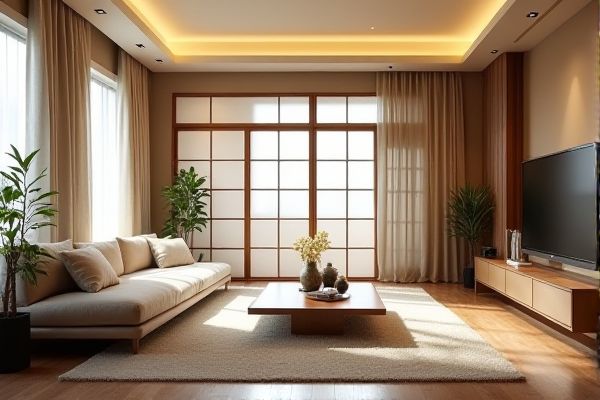
A folding screen offers portable and flexible privacy through adjustable panels, making it perfect for temporary or decorative room division, while a curtain divider provides a softer, more continuous barrier ideal for controlling light and sound in a space. Explore the rest of the article to discover which option best suits your needs and style preferences.
Table of Comparison
| Feature | Folding Screen | Curtain Divider |
|---|---|---|
| Material | Wood, metal, fabric panels | Fabric, polyester, blackout materials |
| Portability | Highly portable, easy to move | Fixed, requires mounting hardware |
| Setup | Freestanding, no installation needed | Installed using rods, tracks, or hooks |
| Privacy | Provides full visual barrier | Offers flexible privacy, can be open or closed |
| Space Usage | Requires floor space to stand | Minimal floor space, hangs vertically |
| Design | Varied styles, decorative panels | Wide range of fabrics and patterns |
| Durability | Sturdy frames, long-lasting | Fabric prone to wear, less durable |
| Cost | Moderate to high depending on material | Generally affordable and budget-friendly |
Introduction: Folding Screen vs Curtain Divider
Folding screens provide a portable, stylish partition made from solid panels, offering privacy with decorative designs and easy repositioning. Curtain dividers utilize fabric hung from ceiling tracks, delivering flexible coverage that can be drawn open or closed to suit space needs. Your choice depends on whether you prioritize mobility and aesthetic appeal or versatility and space efficiency.
Design and Aesthetics
Folding screens offer a versatile design with intricate patterns and materials, providing a decorative focal point that can complement various interior styles from traditional to modern. Curtain dividers deliver a softer, more fluid aesthetic, available in numerous fabrics and colors to enhance ambiance and create a cozy atmosphere. Both options adapt to spatial needs, but folding screens tend to add structure and visual interest, whereas curtain dividers emphasize lightness and flexibility.
Space-Saving Capabilities
Folding screens offer exceptional space-saving capabilities due to their collapsible design, allowing users to easily fold and store them when not in use, making them ideal for small apartments or multifunctional spaces. Curtain dividers, while also space-efficient, require a fixed mounting point and may take up vertical space but do not reduce floor area, making them less flexible for frequent relocation. Both options maximize spatial efficiency, but folding screens provide greater portability and adaptability for dynamic room configurations.
Privacy and Functionality
Folding screens offer flexible privacy with adjustable panels that can be easily repositioned to create temporary, segmented spaces, making them ideal for dynamic environments. Curtain dividers provide continuous privacy, effectively blocking sight and sound when drawn, and they excel in covering larger areas with minimal installation. Both options enhance functionality by allowing customizable space division, but folding screens add mobility, while curtains deliver seamless coverage.
Material Durability
Folding screens often feature materials like wood, metal, or high-quality fabric, providing robust durability and long-lasting performance in various environments. Curtain dividers typically use lighter fabrics such as polyester or cotton blends, which may wear out faster and require more frequent replacement. Choosing a folding screen ensures greater resistance to wear and tear while maintaining structural integrity over time.
Installation and Portability
Folding screens offer easy installation with no mounting required, allowing users to simply unfold and position them instantly, making them highly portable for frequent relocation. Curtain dividers necessitate mounting hardware such as rods or tracks, which can involve more complex installation but provide a permanent or semi-permanent solution. The lightweight nature and collapsible design of folding screens enable effortless storage and transport, while curtain dividers are less mobile due to fixed installation points.
Maintenance Requirements
Folding screens require minimal maintenance, typically involving occasional dusting and cleaning of fabric or wooden panels to keep them looking fresh. Curtain dividers demand regular washing or dry cleaning to prevent dust buildup and maintain fabric quality, which can be more time-consuming depending on the material. Your choice between these two options should consider the ease of upkeep to fit your lifestyle and maintenance preferences.
Cost Comparison
Folding screens typically have a higher upfront cost due to their durable materials and decorative designs, often ranging from $100 to $500 or more. Curtain dividers are generally more budget-friendly, with prices starting as low as $20 for basic panels, making them an economical choice for large spaces. Maintenance and longevity of folding screens can justify their initial cost, while curtains may require frequent replacement, impacting overall expenses.
Versatility in Home Decor
Folding screens offer high versatility in home decor by providing movable, customizable partitions that add texture and visual interest with various materials and designs. Curtain dividers contribute flexibility by allowing easy adjustments in openness and light control, with options ranging from sheer to blackout fabrics that suit different ambiance needs. Both options effectively create multifunctional spaces, but folding screens emphasize structural style while curtains prioritize softness and adaptability.
Environmental Impact and Sustainability
Folding screens often utilize materials like wood, bamboo, or fabric, making them a sustainable choice when sourced responsibly, whereas curtain dividers typically rely on synthetic fabrics that may contribute to environmental pollution through microplastic shedding. Reusable and durable folding screens reduce waste over time, while curtains frequently require washing and replacement, increasing water and energy consumption. Choosing a folding screen for Your space can support eco-friendly practices by minimizing single-use textiles and promoting longer product lifespans.
 homyna.com
homyna.com